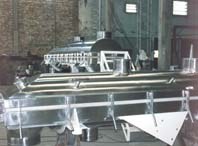Today fluid bed drying processes constitute an efficient alternative for product dehydration.
This process consists of a heat and mass transfer that occurs within the equipment, enabled through the product close contact with the drying gases within the fluid bed.
In continuous fluid bed dryers, the feeding is introduced through the upper part of the fluid bed. This feed falls and gets in touch with a hot air flow, which produces the fluidization and evaporating action.
Due to the high heat transfer coefficient achieved with this process, the continuous fluid bed dryer can be located as equipment of medium residence time, allowing thermo-sensitive product dehydration.
This process is well known for products that require limited reduction of moisture and defined granulometric properties.
However, in the discontinuous fluid bed, the product to be dehydrated must be able to bear high residence times.
For both cases, the heat transfer depends on the moisture of the product to be processed and both gas temperature and bed height can be varied and compatible with the equipment design.
Applications:


